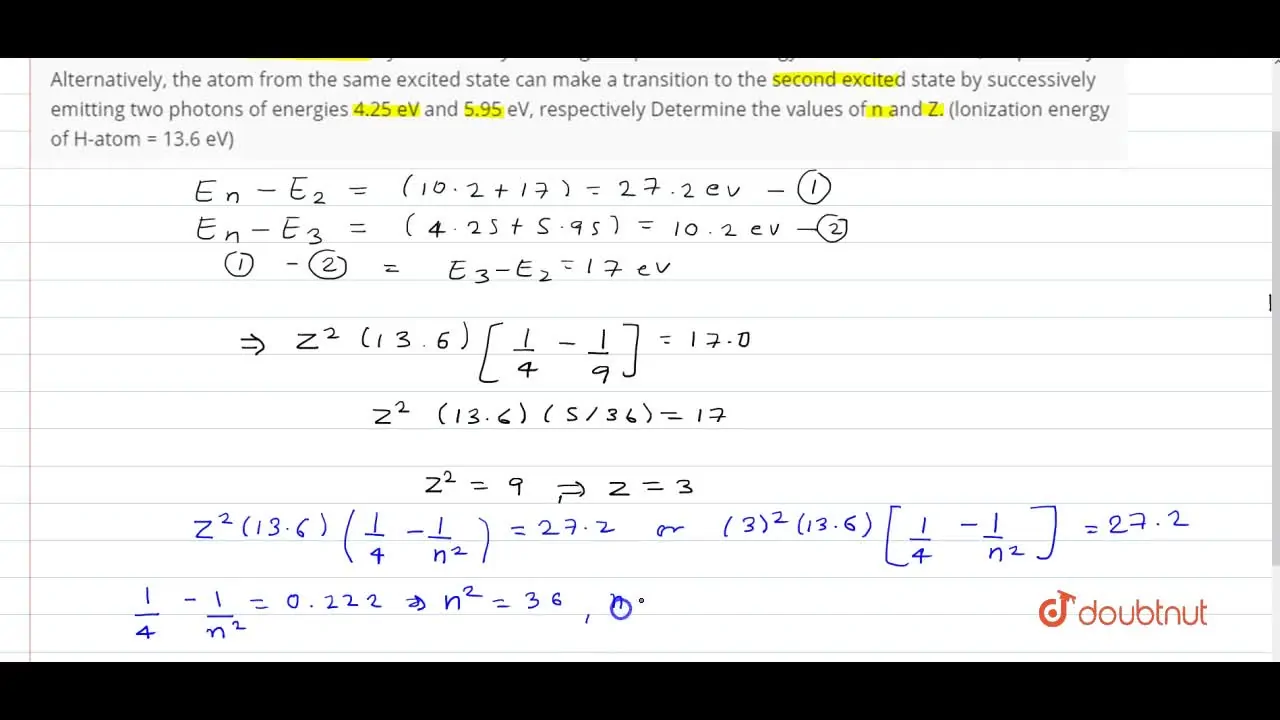A hydrogen like atom (atomic number Z) is in a higher excited state of quantum number n. The excited atom can make a transition ot the first excited state by successively emitting two photons of energy 10.2 eV and 17.0 eV, respectively. Alternatively, the atom from the same excited state can make a transition to the second excited state by successively emitting two photons of energies 4.25 eV and 5.95 eV, respectivley Determine the values of n and Z. (lonization energy of H-atom = 13.6 eV)
From the given conditions, En−E2=(10.2+17)eV=27.2eV ….
and En−E3=(4.25+5.95)eV=10.2eV ….(ii)
Eq (i) - Eq(ii) gives E3−E2=17.0eVorZ2(13.6)(14−19)=17.0
⇒Z2(13.6)(5/36)=17.0
⇒Z2=9orZ=3
From Eq .(i), Z2(13.6)(14−1n2)=27.2or(3)2(13.6)(14−(1)(n2)=0.222or1n2=0.0278
or n2=36⇒n=6.
Related Playlists
- BOOK - DC PANDEYCHAPTER - MODERN PHYSICS - 1EXERCISE - Example Type 34videos
MODERN PHYSICS - 1
- BOOK - DC PANDEYCHAPTER - MODERN PHYSICS - 1EXERCISE - Example Type 43videos
MODERN PHYSICS - 1
- BOOK - DC PANDEYCHAPTER - MODERN PHYSICS - 1EXERCISE - Example Type 12videos
MODERN PHYSICS - 1
- BOOK - DC PANDEYCHAPTER - MODERN PHYSICSEXERCISE - Integer Type Questions17videos
MODERN PHYSICS
- BOOK - DC PANDEYCHAPTER - MODERN PHYSICS - 2EXERCISE - Level 2 Subjective10videos
MODERN PHYSICS - 2
Similar Questions
A hydrogen like atom (atomic number z) is in a higher excited state of quantum number n. This excited atom can make a transition to the first excited state by successively emitting two photons of energies 10.2eV and 17.0eV respectively. Alternatively the atom from the same excited state can make a transition to the second excited state by successively emitting 2 photons of energy 4.25eV and5.95eV respectively. Determine the value of (n+z)
View SolutionA hydrogen like, atom ( atomic number =Z) is in a higher excited state of quantum number n. This excited atom can make a transition to first excited state by successively emitting two photons of energies 10.20eV and 17.0 eV respectively. Alternatively, the atom from the same excited state can make a transition to second excited state by successively emitting two phons of energy 4.25 eV and 5.95eV respectively. Determine the values of n and Z.
View SolutionA hydrogen-like atom (aatomic number Z) is in a hight excited state of quantum number n . This excited atom can make a transition to the first excited state by successively emitting two proton of energy 10.20eVand17.00eV, respectively.
Alternatively , the atom from the same excited state can make a transition to the second excited state by successively emitting two proton of energy 4.25eVand5.954eV, respectively. Determine the value of nandZ (ionization energy of hydrogen atom =13.6eV)View SolutionA hydrogen like species (atomic number Z) is present in a higher excited state of quantum number n. This excited atom can make a transitionn to the first excited state by successive emission of two photons of energies 10.20 eV and 17.0 eV respectively. Altetnatively, the atom from the same excited state can make a transition to the second excited state by successive of two photons of energy 4.25 eV and 5.95 eVv respectively. Determine the value of Z.
View SolutionA hydrogen like atom (atomic number z) is in a higher excited state of quantum number n. This excited atom can make a transition to the first excited state by successively emitting two photons of energies 10.2eV and 17.0eV respectively. Alternatively the atom from the same excited state can make a transition to the second excited state by successively emitting 2 photons of energy 4.25eV and5.95eV respectively. Determine the value of (n+z)
View SolutionA hydrogen like atom (atomic number Z) is in a higher excited satte of quantum number n .This excited atom can make a transition to the first excited state by succesively emitting two photon of energies 10.20eV and 17.00eV .Alternatively, the atom from the same excited state can make a transition to the second excited state by successively emitting twio photon of energy 4.25ev and 5.95eV Determine the followings:
The value of atomic number (Z) isView SolutionA hydrogen like atom (atomic number Z) is in a higher excited satte of quantum number n .This excited atom can make a transition to the first excited state by succesively emitting two photon of energies 10.20eV and 17.00eV .Alternatively, the atom from the same excited state can make a transition to the second excited state by successively emitting twio photon of energy 4.25ev and 5.95eV Determine the followings:
The excited sate (n) of the atom isView SolutionA hydrogen like atom (atomic number Z) is in a higher excited satte of quantum number n .This excited atom can make a transition to the first excited state by succesively emitting two photon of energies 10.20eV and 17.00eV .Alternatively, the atom from the same excited state can make a transition to the second excited state by successively emitting twio photon of energy 4.25ev and 5.95eV Determine the followings:
The hydrogen -like atom in the question isView SolutionA hydrogen like atom (atomic number = Z) is in higher excited state of quantum number n. This excited atom can make a transition to first excited state by successively emitting two photons of energy 22.94eV and 5.15eV. The atom from the same state n can make transition to second excited state by successively emitting two photons of energies 2.4eV and 8.7eV. Find values of n and Z.
View SolutionA hydrogen like atom (atomic number Z) is in a higher excited satte of quantum number n .This excited atom can make a transition to the first excited state by succesively emitting two photon of energies 10.20eV and 17.00eV .Alternatively, the atom from the same excited state can make a transition to the second excited state by successively emitting twio photon of energy 4.25ev and 5.95eV Determine the followings:
The atom during transition from n=1 to n=2 emit radiation in the region ofView Solution


